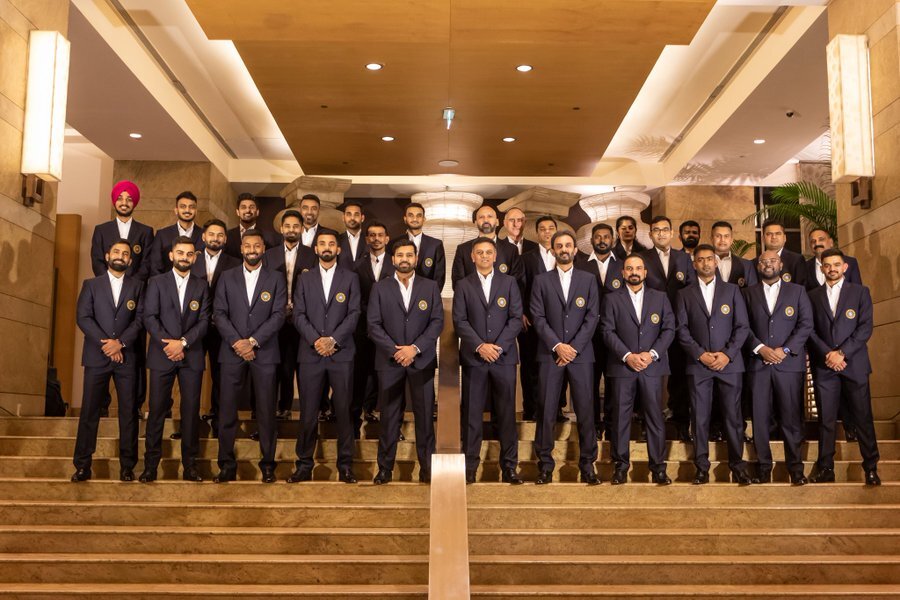Analysis of India's squad for the 2022 Men's T20 World Cup

After star pacer Jasprit Bumrah was ruled out of the T20 World Cup due to a back injury, the Board of Control for Cricket in India (BCCI) announced veteran pacer Mohammed Shami as his replacement. Shami was initially one of the three reserve players, but has now been drafted into the 15-member squad.
After pacer Deepak Chahar was ruled out due to injury, the BCCI announced fast-bowlers Mohammed Siraj and Shardul Thakur as two additional reserve players, alongside batsman Shreyas Iyer and leg spinner Ravi Bishnoi. The three players have already flown to Australia and will be expected to begin training soon.
The following players comprise India’s 15-member squad for the 2022 Men’s T20 World Cup:
Nicknamed “the hitman”, Rohit Sharma has built an incredible reputation over his 15-year career as an international batsman. However, the Indian captain has recently struggled with his form. In the 2022 IPL, for example, he scored only 268 runs for 14 innings with an average of 19.14 and a low strike rate of 120.17. This struggle continued to the Asia Cup, wherein his only significant score was 72 runs off 41 balls against Sri Lanka. Known as a great player of pace, the BCCI management hope he will fire on the quick Australian pitches.
After his hamstring injury at the end of the 2022 Indian Premier League, Rahul was forced to stay out of cricket until India’s bilateral tour of Zimbabwe in August. He struggled to find form through the series and during the subsequent Asia Cup. He began finding a rhythm at the end of the Asia Cup, with a knock of 62 runs off 41 balls against Afghanistan on September 8th. He scored three half-centuries in the bilateral series against Australia and South Africa (a total of 6 matches), but his form is still not completely set in.
Kohli has had a rough couple of years, but he has started to emerge from the shadows. Being the second-highest run-scorer of the 2022 Asia Cup, he showed India hope that he was back with runs. However, his somewhat dismal performances against Australia and South Africa are something to worry about as they highlight his inconsistency. The good thing is that Virat has a good track record on Australian pitches and his experience will be key for any chance of India winning the tournament.
After a somewhat dismal performance in the Asia Cup, Surya has roared back into form by hitting 286 runs from his last 7 T20 matches with an average of 41.8 and a colossal strike rate of 180.29. Known as India’s 360° batsman, Surya’s versatility of wrist shots and muscle means he can hit almost any ball anywhere in the field, making him a huge asset to the Indian side.
A right-hand batsman and right-off-break bowler, Hooda’s selection in India’s T20 World Cup squad came as a surprise for many, considering his poor exhibition in the Asia Cup this August. However, considering his 2022 IPL statistics: 451 runs from 15 innings with an average of 32.21 and strike rate of 136.6, he can be a good fallback batsman and help the team recover in the case of a top-order collapse. The primary reason he was selected over the more popular choices of Sanju Samson or Shreyas Iyer is likely because he can roll his arm and bowl a few overs here and there if required, which both Samson and Iyer cannot do.
Pant’s selection despite his recent poor form indicates the faith of the Indian management in him. Batting notwithstanding, Pant is an ideal selection for the fast Australian pitches. Here, India will require an experienced and exceptionally talented wicketkeeper to keep dot balls from flying to the boundary due to the extra pace generated by the pitch, and Pant is the right man for that. Despite their hopes, the Indian management should expect that Pant won’t contribute much with the bat though, as his shot personality and presentation is more suited for ODIs and Test matches.
At age 37, Dinesh Karthik lives the “underdog always has its day” story to the fullest. After twelve years of poor to decent form, Karthik finally received his call to duty from the BCCI after a phenomenal 2022 IPL, in which he scored 330 runs in 16 innings as a finisher with a strike rate of 187.28. Though his wicketkeeping skills aren’t as sharp as those of Rishabh Pant, Karthik is the 1st choice wicketkeeper/batsman for the Indian management due to his ability to bat under pressure.
Pandya has impressed with both the ball and the bat in recent fixtures. His ability of bowling quick and random bouncers has caught many batsmen by surprise and has led to the taking of crucial wickets in matches India won. Meanwhile, his variable batting ability has made him a steady all-rounder and finisher for the Indian team. He will likely play all of India’s games in the T20 World Cup.
After all-star Ravindra Jadeja’s knee injury ruled him out of the T20 World Cup, Axar Patel was the most logical choice. Considered a “like-for-like” player for Jadeja, Axar is a left-arm off-spinner and batsman. While wondrous on Indian pitches, Axar’s bowling will be put to the test in Australia, where the ball doesn’t turn as much. A good fielder, he will be a good asset in Australia’s massive fields and his throwing accuracy can help India get dangerous batsmen run out. Unlike Jadeja though, Axar isn’t very strong with the bat, having only hit 61 runs in his previous 7 T20i innings with an average of 10.17 and strike rate of 135. If he wants to continue playing for Team India as an allrounder, Axar will have to prove his worth with the bat in this tournament, especially when the top order collapses.
One of the more experienced players on the Indian side, Ashwin’s knowledge of various opposition players could prove to be helpful in dismissing them. However, a 36-year-old right-hand batsman and right-arm off-break bowler, Ashwin may have age against him. He has been sloppy with his fielding in the past and his bowling has resulted in quite a few wides in recent years. It is very important that the Indian management stress Ashwin’s role: a fallback player who bats down the order (likely at 7 or 8) to stabilize innings in the case of a top-order failure. His aggressive batting nature, coupled with his calm complexion, makes him a good candidate for this role, and it is the hope of all Indians that he lives up to expectations.
Chahal has had a tumultuous past few years, with a lack of consistency in his bowling. Often nicknamed the “chess master”, Chahal relies on old-school techniques like flight and turn, along with a variety of pitch and bounce lengths to confuse batsmen and get them out. This technique worked well for him in the 2022 IPL, in which he won the Aramco purple cap for taking the highest number of wickets. It will be interesting to see how Rahul Dravid and his associates use Chahal on the Australian pitches.
Nicknamed the “swing king”, Bhuvi has led the Indian bowling attack for many years now. Now 32, he is edging past his prime, and this is visible in that he leaks too many runs in the 18th and 19th overs (when the ball doesn’t swing as much). Despite this, his experience and effectiveness in the powerplay are almost unmatched, making him a very valuable asset to the Indian side.
Harshal Patel’s inclusion in the Indian side has come as a surprise for many, considering his poor performances against both South Africa and Australia. From the get-go, Harshal has relied on variations in length and bounce to get wickets and conserve runs, but batsmen have started catching onto his bowling lines early and smacking him for sixes. Many former cricket players have voiced their concern regarding Harshal’s inclusion in the squad over the likes of Umran Malik and Mohammed Siraj, who bowl significantly faster and concede marginally lower runs. It is likely Harshal’s ability to provide with the bat as well that encouraged the Indian management to choose him, but whether he can actually make a difference in a match with the bat is yet to be seen.
Arshdeep’s selection came as no surprise after good performances against South Africa and Australia. The 23-year-old has phenomenal pace and swing with the ball, and he is quickly improving his death bowling abilities. In the next 5-7 years, within which players like Shami and Bhuvneshwar will retire, Arshdeep will get a big role in India’s T20 bowling attack, and the BCCI is prepping him for it by giving him lots of experience.
A replacement for Jasprit Bumrah, Shami has proved to be a lethal asset for the Indian team in the past with his impeccable speed and swing. Like Bhuvneshwar Kumar though, Shami is also edging past his prime, and his bowling doesn’t have the same speed as it used to. He had a good IPL this year, picking up 19 wickets in 15 matches with an economy of 8, but was hit for runs against England in the India vs England bilateral series during July. Despite this, Shami’s experience will prove to be invaluable to getting key players out, and his presence heavily boosts the Indian bowling department.
